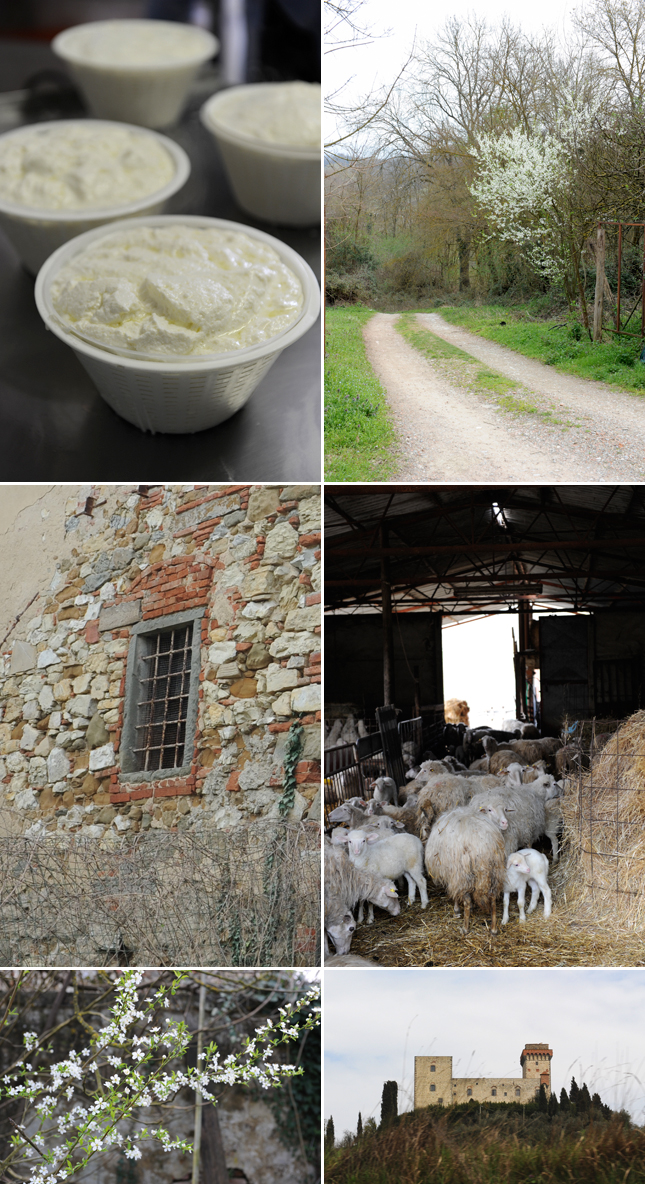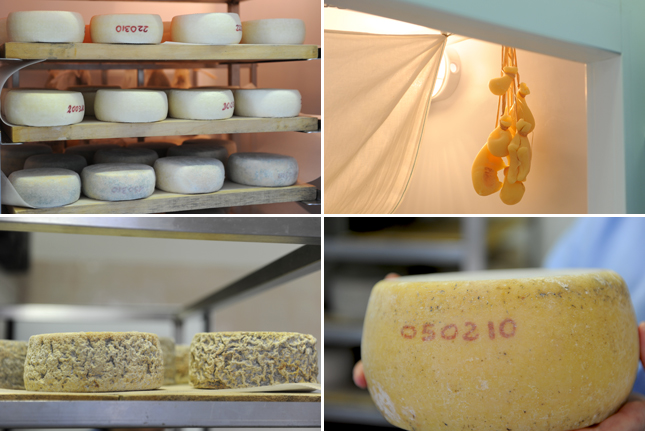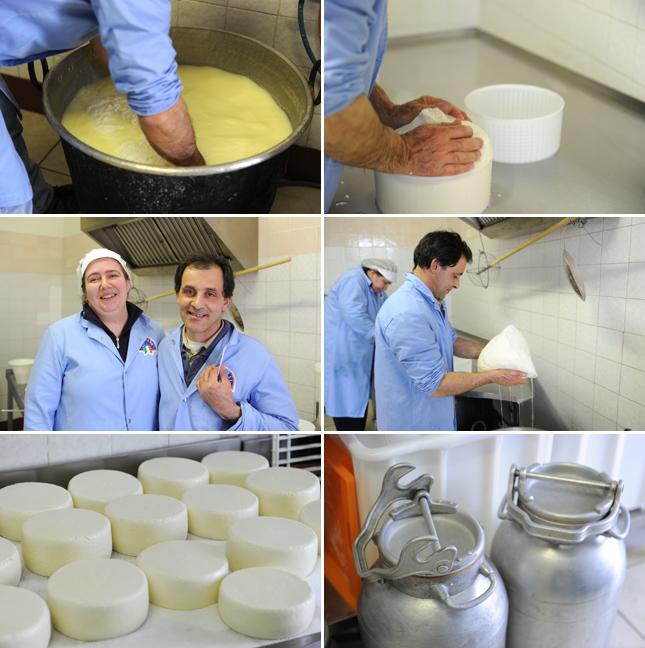Tuscan Cheese - formaggio Toscano

It is hard to imagine now, but once the young Eternal City was surrounded by pastureland where sheep grazed in great numbers. These sheep, obviously, provided a steady stream of milk. Also, there was a ready supply of salt from the seaside town of Ostia and the Romans had a monopoly on salt after winning the Punic Wars, therefore the cost of making cheese in Rome was low. In plentiful times pecorino became a staple in the Roman legionaries rations and the patriotic, or just plain hungry, citizens of Latium were eating only sheep’s milk cheese since drinking or eating anything made from cow’s milk was considered barbaric or worse, “Germanic.” Later in Rome’s history sheep’s milk and cheese became more of a premium commodity, one so valuable that the Emperor Diocletian, a man who might rightfully be called the father of Italian bureaucracy, personally set sheep’s milk prices.
Pecorino remained a predominantly Roman delight up until 1884 when the local administration banned the salting of cheeses in local cheese shops and pecorino production moved to the island of Sardinia where it flourished until the end of WWII¹. This may have been a result of an increase in salt tax.² After the war Italy was a ravaged and poor place causing mass migrations within and beyond the country. Many Italians left while others, notably Sardinians, moved to Tuscany where the Toscanos were abandoning their farms for factories. Naturally, the Sardinians brought along their sheep and their cheese making methods.

A descendent of one such Sardinian is Salvatore Farris, owner/operator of La Torraccia in Reggello, whose grandfather was among the early Sardinian arrivals. Here, in the shade of a Florentine castle, Farris, along with Elisabetta Focardi, make formaggio pecorino by hand using the method that is over 35 centuries old.
Pecorino is a “cooked” cheese. The process begins by raising the temperature of the fresh sheep’s milk to 70℉/21℃ degrees and adding rennet³ which causes the milk to curdle as it heats. To make about three standard size wheels of Pecorino Toscano you’ll need around 16 gallons/60 liters of sheep’s milk. To get this amount of milk you will need at least 60 sheep as each ewe only produces one to two liters of milk a day. When the milk reaches 40℉/4.5℃ salt is added. At 60℉/15.5℃ more raw sheep’s milk is added. Once the milk comes to temperature the cheese curds separate from the whey (siero in Italian) and sink. The cheese-maker then shapes the sunken curds into a log shape, cuts off sections and places the sections in a basket where they are shaped and pressed further to release the excess liquid. This liquid whey drains back into the original cauldron where it is reheated with the leftover whey and made into to another great Italian cheese, ricotta. (Ricotta meaning, of course, “re-cooked.”) Once shaped and fully drained the wheels are aged in a 50℉/10℃ refrigerator for 20 days then moved to a 57℉/14℃ cellar for a minimum of four months after which they are known as Pecorino Toscano stagionato.
Due to the increased industrialization in the world of cheese handmade pecorino is becoming less the Italian kitchen staple it once was and more of a specialty item. At La Torraccia, Farris, like the best artisanal cheese makers, oversees the entire process from the tending of his flock, to the shaping of each wheel, to selling his product right out the front door of the dairy. The end result are cheeses that are true expressions of Tuscan terroir.
Pecorino cheese gets its name from the Italian word pecore, which means, sheep. It is one of Italy’s oldest cheeses. The ancient author Varro wrote about cacio Marzolina (March cheese) in 20-something BCE. Pliny the Elder describes the Tuscan pecorino in book XI of Naturalis Historia written around 70 CE.
Some of the pecorino made in Tuscany is designated DOP. Only with this designation can one call their cheese ‘Pecorino Toscano’. “Denominazione d'Origine Protetta” (DOP) along with “Indicazione Geografica Protetta” (IGP) are the certification titles attached to unique, regional products. The Byzantine legalities and bureaucratic verbiage attached to these certifications are reducible to this idea: The DOP and/or IGP marks guarantee the authenticity and genuine characteristics of certain food and agricultural products from specific locations.
Only 35 out of about 600+ Italian cheeses are protected. Not protected as in behind glass, in a safe or moved from farm to table in armored cars, but protected by the EU and the Italian government. These safeguarded cheeses, along with other artisanal food products such as hams, olive oils and vinegars, are not just regional, national and cultural assets, they are monetary assets. Assets of such value that the Italians have fought and won international court battles to protect what can only be called their regional copyrights; the most recent and highly profiled was the fight to make make it illegal to call a cheese Parmesan unless it comes from Parma.
Fellow sheep’s milk cheeses that are also protected are the pecorinos of Romano, Sardo, Siciliano and di Filiano — being the most recent addition to the in-crowd earning DOP statues in 2007.
Recipe - Fava Beans and Fresh Pecorino

1.) The pecorino cheese makers of Sardinia have staged a come back and most of the Pecorino Romano available today comes from the island.
2.) Salt taxes have been a part of Italian culinary life, indeed global culinary life. Salt taxes in Italy were a burden to the populous even in ancient Roman times but came to a head in the Renaissance. For a complete picture consult: Papal banking in Renaissance Rome: Benvenuto Olivieri and Paul III, 1534-1549 by Francesco Guidi Bruscoli, chapter 7, pages 145-153.
3.) Rennet is used in most cheese making. When added to milk it causes the milk solids to curdle. There are now several types of rennet. The first rennets were made from the lining of calf’s and kid’s (young goats) stomachs. Their stomachs contain enzymes not found in the stomachs of older cattle that are essential in offspring being able to digest mother’s milk. Other rennets are made from artichoke. Farris uses artichoke rennet in his Marzolino. There are also other rennets available today that are vegetarian friendly. The most commonly used is called chymosin and it is produced using genetically engineered bacteria.
Contact:
Salvatore Farris/Elisabetta Focardi
La Torraccia Pecorino Cheese & Ricotta
Az. Agricola Farris, Salvatore
Via Cetina La Torraccia, 47
50066 Reggello, FI, Italy
T: (+39) 055 863332
E-mail: info@latorraccia.it
Pecorino Toscano D.O.P.
Via Mameli
17
58100 Grosseto,
Italy
T: (+39) 0564 20038
Email: info@pecorinotoscanodop.it






 Share Article
Share Article